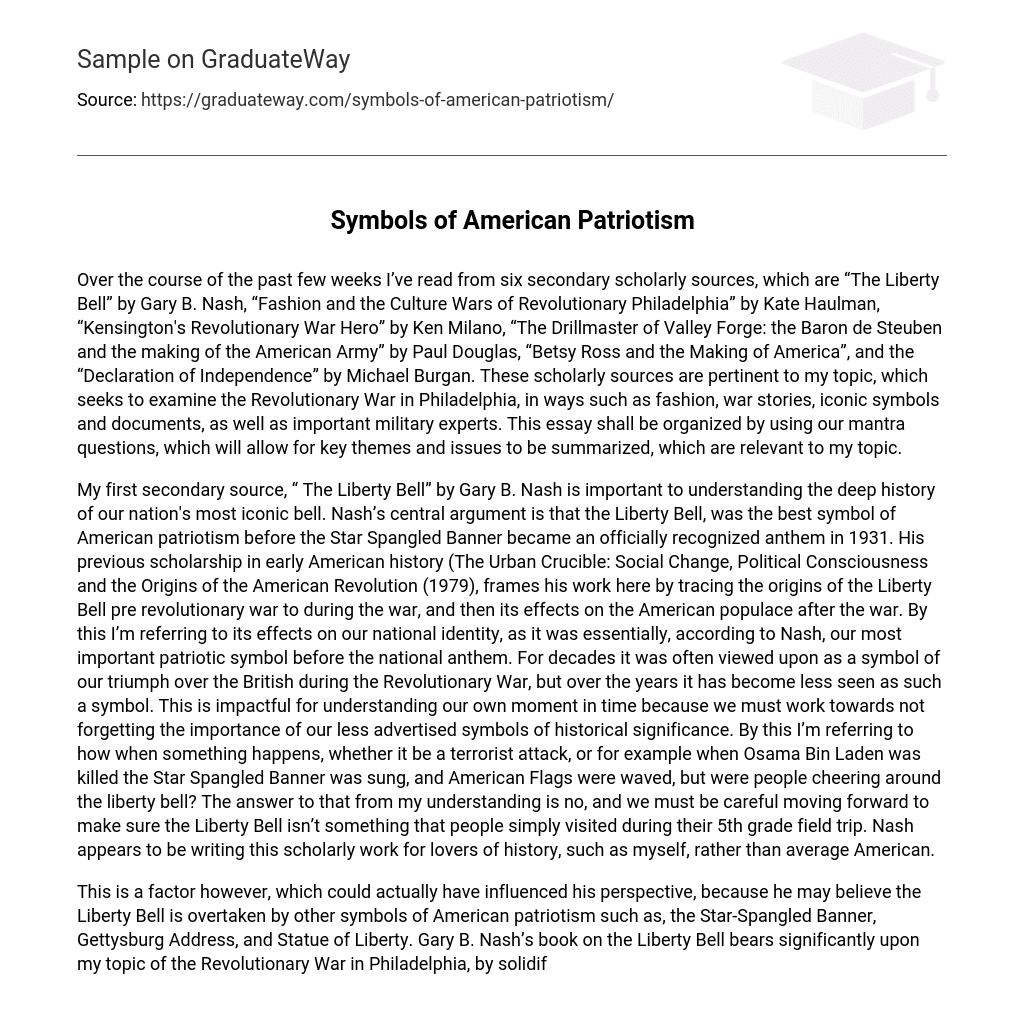Over the course of the past few weeks I’ve read from six secondary scholarly sources, which are “The Liberty Bell” by Gary B. Nash, “Fashion and the Culture Wars of Revolutionary Philadelphia” by Kate Haulman, “Kensington’s Revolutionary War Hero” by Ken Milano, “The Drillmaster of Valley Forge: the Baron de Steuben and the making of the American Army” by Paul Douglas, “Betsy Ross and the Making of America”, and the “Declaration of Independence” by Michael Burgan. These scholarly sources are pertinent to my topic, which seeks to examine the Revolutionary War in Philadelphia, in ways such as fashion, war stories, iconic symbols and documents, as well as important military experts. This essay shall be organized by using our mantra questions, which will allow for key themes and issues to be summarized, which are relevant to my topic.
My first secondary source, “ The Liberty Bell” by Gary B. Nash is important to understanding the deep history of our nation’s most iconic bell. Nash’s central argument is that the Liberty Bell, was the best symbol of American patriotism before the Star Spangled Banner became an officially recognized anthem in 1931. His previous scholarship in early American history (The Urban Crucible: Social Change, Political Consciousness and the Origins of the American Revolution (1979), frames his work here by tracing the origins of the Liberty Bell pre revolutionary war to during the war, and then its effects on the American populace after the war. By this I’m referring to its effects on our national identity, as it was essentially, according to Nash, our most important patriotic symbol before the national anthem. For decades it was often viewed upon as a symbol of our triumph over the British during the Revolutionary War, but over the years it has become less seen as such a symbol. This is impactful for understanding our own moment in time because we must work towards not forgetting the importance of our less advertised symbols of historical significance. By this I’m referring to how when something happens, whether it be a terrorist attack, or for example when Osama Bin Laden was killed the Star Spangled Banner was sung, and American Flags were waved, but were people cheering around the liberty bell? The answer to that from my understanding is no, and we must be careful moving forward to make sure the Liberty Bell isn’t something that people simply visited during their 5th grade field trip. Nash appears to be writing this scholarly work for lovers of history, such as myself, rather than average American.
This is a factor however, which could actually have influenced his perspective, because he may believe the Liberty Bell is overtaken by other symbols of American patriotism such as, the Star-Spangled Banner, Gettysburg Address, and Statue of Liberty. Gary B. Nash’s book on the Liberty Bell bears significantly upon my topic of the Revolutionary War in Philadelphia, by solidifying the importance of its role during the war. For example, the Liberty Bell war rung four days after the signing of the Declaration of Independence, which is something many people may not know happened. From the early onset of the war it was being used as a symbol of American pride, and Philadelphian pride.
Kate Haulman’s scholarship on fashion and culture wars in Philadelphia during the Revolutionary War is highly intriguing, and bears on my topic by giving insight on the lives of ordinary citizens in the midst of the war. The key question which drove her research was this, “How was fashion political in eighteenth century British North America?”. Her previous scholarship in ‘Rods and Reels: Social Clubs and Political Culture in Early Pennsylvania,’, and “Room in Back: Before and Beyond the Nation in Women’s/Gender History,” help to frame her work here by displaying her interest in societal structures, cultures, and gender. Her research methods involve using examples of events during the British occupation of Philadelphia from 1777-8. For example, she cites anxiety amongst Continental soldiers, due to colonial women forming alliances with British soldiers. Such alliances were noticeable in the ways women were dressed, such as elite women, to which Haulman uses the Meschianza, as an example for political loyalties in Philadelphia during the occupation. The Meschianza, according to Haulman was an event organized by John Andre to celebrate the departure of General Howe. At this event one could see the way in which women were dressed, and was indicative of political allegiances.





